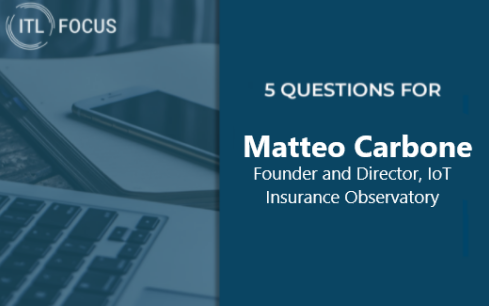
As part of this month’s ITL Focus on smart homes, we spoke with Matteo Carbone, the founder and director of the IoT Insurance Observatory, about how far the technology and adoption have progressed and where the market goes from here.
ITL:
Let’s start with a status update. You’ve focused on telematics for a decade and founded the Observatory five years ago to do research and consulting. You began in Europe and then expanded to the U.S. You’re in Sao Paolo as we speak, exploring the possibility of expanding into South America. So you have a very broad perspective. Where do you think we are in terms of our progress toward the smart home?

Carbone:
In the U.S. market, the mood is similar to what it was on personal auto telematics in 2017. At the first plenary session of the Observatory in the U.S., an executive said in a speech, “We tried it. It does not work.”
The people who took that attitude are now behind and trying to close the gap, but there’s four or five years of gap to close, and learning to use telematics data takes time. You can copy a product in six months, but it takes years to build the capability to use IoT data.
Today, we have the same mood among insurers about the smart home, and I’m telling people not to make the same mistake that they made on personal auto telematics.
ITL:
Are other markets more advanced than the U.S.? Or is the U.S. pretty representative of what's happening around the world?
Carbone:
I think two markets are considerably more advanced. One is France. Smart home insurance there uses sensors to detect smoke, the presence of water on the floor and so on, but the main value proposition to customers is security. Insurers are cross-selling to their existing portfolio of homeowner and renter clients, and there are millions of policyholders who purchased this assistance product that includes security and mitigation of other property risks.
ITL:
And the other more advanced market?
Carbone:
The second one is the U.K. Probably you remember NEOS, which built a portfolio of 200,000 smart home policies from scratch. In addition, many insurers for high-net-worth individuals are offering water leak detectors from a company called Leakbot. These aren’t the normal sort of detectors, which require that a problem has already happened – there’s water on the floor. These detect small leaks, so you spot problems that aren’t yet visible. There are almost no claims, because any damage is below the deductible. And the detectors don’t require professional installation.
In the pilots in the last couple of years, we’ve seen a return on investment, so insurers have started to offer these devices in this high-end segment for free.
ITL:
In terms of the U.S. market, what do you think has to happen for insurers to get interested in the market and take the next step? Is it just a matter of getting moving? Is it a matter of technology?
Carbone:
I think the game changer will be when one incumbent starts to show results. From what I know -- that I cannot disclose because I have nondisclosure agreements – we are not too far from this moment. There is one large incumbent in the U.S. that is moving from the final test to something that it's trying to scale. The results will be confirmed in the next probably 12 months.
ITL:
If you can tell me, will the main feature be security? Will it be water leaks? Or will it be something else?
Carbone:
The use case is more around fire prevention, detecting a risky situation before a fire breaks out.
ITL:
That's interesting. I’ll be fascinated to see how the rollout goes.
That's basically what I wanted to cover, is there anything else you're seeing or hearing about smart homes that you think we should know?
Carbone:
There is an interesting initiative by Mercury in California. They started to propose to their policyholders a device that shuts off water. These devices [Flo by Moen] were analyzed one or two years ago by LexisNexis, and the cost is high enough that it takes many years for an insurer to reach break-even. But Mercury recently began offering these devices to policyholders in California for around a $200 fee. That is a way to have a more sustainable insurance business case.
ITL:
Fascinating, as always. Thanks so much, Matteo.











